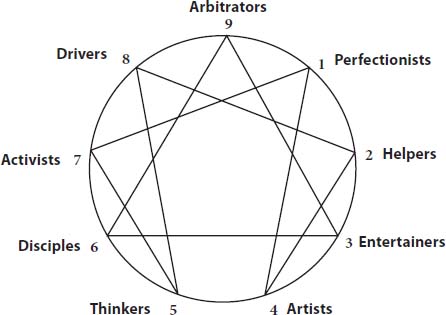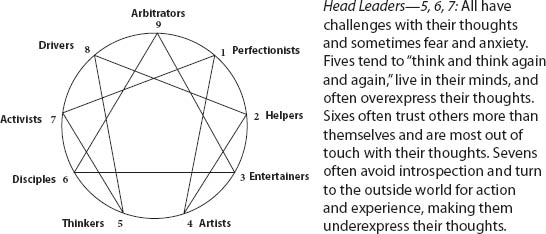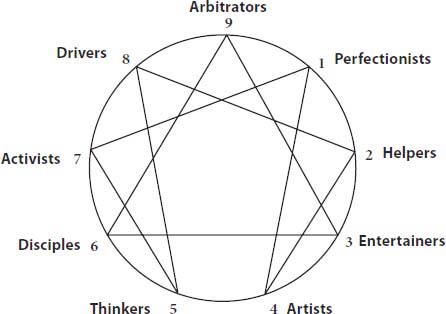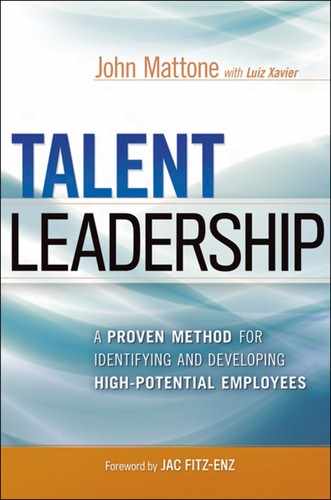CHAPTER 7
Psychodynamic Model of Executive Maturity: The Enneagram
Traditionally, power has been centralized at the top of organizations. However, unrelenting external and internal challenges—fierce global competition, an aging baby boomer population, instability in the financial and job markets, and increased corporate governance—have forced organizations to rethink how they identify, promote, and develop leaders. Organizations have also responded by creating flatter structures and transferring decision-making authority to employees throughout the organization. In essence, organizations now require individuals at all levels to be leaders; to thrive and survive in today’s organization, all employees must be leaders.
Unfortunately, not all employees are ready and willing to take on the leadership responsibilities their organizations want (and need) to give them. An examination of how society is structured reveals why. From the moment of birth, people hold subordinate roles in society. At birth, people are exposed to their first bosses, their parents. Children accept the leadership of their parents because they are entirely dependent on them. As a result, most children are used to being told what to do by their parents. Rare is the case where children tell their parents what to do. Once children enter school, they are exposed to other bosses, their teachers. Similarly, if they attend church, mosque, or temple, they were exposed to a similar power dynamic in the form of priests, ministers, rabbis, or mufti. Thus, by the time someone enters an organization that grants them the power to make decisions, many of these individuals may have no prior leadership or decision-making experience to draw on.
Without the necessary skill or experience in leadership, most young leaders will default to leading based on their own values and beliefs—their inner core. Unfortunately, most young leaders are not entirely aware of their own values, beliefs, strengths, or weaknesses; ultimately, the combination of these elements shapes and defines a leader’s unique style. The Enneagram is a powerful tool that helps all leaders and future leaders gain the necessary self-understanding required for recognizing their own strengths and weaknesses. Secure in the knowledge of who they are and what their potential is, leaders are able to execute better decisions, lead change, build teams, communicate, and resolve conflict in ways that drive new levels of success—for their organization, teams, employees, and themselves. A leader with heightened self-awareness is able to read and understand other people and build the so-called bridge of versatility that connects their inner core with their outer core competencies and skills.
The Enneagram distinguishes among nine distinct personality types (Exhibit 7.1). Although everyone exhibits an inner core and behavioral tendencies primarily associated with one predominant type, everyone also exhibits, to a somewhat lesser degree, an inner core and behaviors associated with each of the other types. The exact origins of the Enneagram remain unknown. Some trace its origins to Babylon in 2500 BCE. Many agree that the Sufis popularized the use of the Enneagram in the tenth century. The word itself comes from the Greek words ennea, meaning nine, and gram, meaning “something written or drawn.” Each of the nine points on the Enneagram corresponds to a distinct way of thinking, feeling, and behaving. Thus, people at different points on the Enneagram view the world and interact with the world differently. The Enneagram continues to be used after thousands of years because of one simple reason: It works.

The Enneagram offers notable advantages over other psychological assessments. The main advantage of the Enneagram is that it identifies the strengths and relative maturity level associated with a leader’s inner core attributes—thoughts, feelings, values, beliefs, and behavioral tendencies. The Enneagram correlates with other well-known personality and behavioral assessments that are based on the five-factor theory (e.g., Myers-Briggs, DISC, and Hogan); however, the Enneagram provides more granular detail on executive maturity and further defines clear development paths so that leaders can more accurately define and target their development goals and strategies. Many other approaches to leadership development focus primarily on changing behaviors. Such approaches may result in only short-term changes. Without understanding why they act the way they do, leaders may fall back to their original behavioral patterns after a while. Falling back on old habits is more likely to occur in stressful and uncertain situations, the exact types of situations that characterize most workplace environments today. Thus, interventions that focus solely on behavioral change are likely doomed to fail. Only by understanding the underlying reasons for a person’s action can lasting change occur. The Enneagram is able to identify the underlying factors people value most. By understanding their deep-seated values, leaders can better understand why they act the way they do. This in turn can lead to lasting behavioral change.
The Enneagram also offers greater precision than other psychological assessments. Instead of categorizing people into four or five broad categories, the Enneagram categorizes people into nine. By including more subcategories, the Enneagram is better able to capture the subtle differences among people. Lastly, the Enneagram isn’t a one-time assessment. It is designed to track changes over time and to continually measure the developmental changes people undergo.
Breaking Down the Enneagram
The Enneagram consists of a circle divided into three main parts or groupings: Heart Leaders, Head Leaders, and Gut Leaders. The Enneagram does not pigeonhole people as possessing traits related to only one of the groupings. It recognizes that everyone is part Heart, Head, and Gut. At the same time, different people tend to exhibit characteristics presented in one of the groupings more than the other two. In other words, everyone is predominantly a Heart (Exhibit 7.2), Head (Exhibit 7.4), or Gut Leader (Exhibit 7.3).

Exhibit 7.3: Gut Leaders


Each of these groupings is too broad to accurately capture the variety and complexity of human behavior. For this reason, each of the three major groupings is subdivided into three distinct personality subtypes. Heart Leaders tend to be Helpers, Entertainers, or Artists. Head Leaders tend to be Activists, Disciples, or Thinkers. Gut Leaders tend to be Drivers, Arbitrators, or Perfectionists. Similar to how people tend to be more Feelers, Doers, or Relaters, people tend to exhibit behavioral characteristics associated with one subgroup more than the others. In other words, someone who is predominantly a Feeler may be predominantly a Helper, Entertainer, or Artist. At this point, understanding the differences between each of the nine subcategories is not important. The differences among the nine subcategories will become clearer in subsequent chapters and through the use of the Enneagram.
Because Enneagramists differ on the names they give the nine personality types—one person’s Disciple is another person’s Loyalist—they’ve assigned a number to each type. These numbers remain constant regardless of the label used. This is why some people refer to themselves based on their number rather than the personality label.
Each of the subcategories in the three overarching categories differs in their relationship with the dominant trait in the overarching category. One of the subcategories overdevelops the character trait, another underdevelops the character trait, and the last is out of touch with the character trait. In the Heart Leader triad, Helpers have overdeveloped their feeling characteristics, Entertainers are out of touch with their feeling characteristics, and Artists have underdeveloped their feeling characteristics. Within the Head Leader triad, Activists have overdeveloped their thinking characteristics, Disciples are out of touch with their thinking characteristics, and Thinkers have underdeveloped their thinking characteristics. Within the Gut Leader triad, Drivers have overdeveloped their gut characteristics, Arbitrators are out of touch with their gut characteristics, and Perfectionists have underdeveloped their gut characteristics.
Heart Leaders
Whether someone is a Helper, Entertainer, or Artist, Feelers share characteristics relating to how they feel about themselves and others. Their greatest strengths and greatest weaknesses are their emotions. When these types develop in mature ways, their feelings are the focus of what is admirable about them. Conversely, their feelings are the source of most of their problems. Heart Leaders who begin to derail perceive that they cannot be respected and appreciated for their own sakes. As a result, they develop a broad spectrum of strategies to earn the respect and appreciation of others. The central problem facing derailing Heart Leaders typically involves their identity. Instead of developing their true identities, they will sometimes focus their energies on developing socially admirable identities. Helpers (Twos) focus on making themselves likable to others; Entertainers (Threes) direct their energies to building a respected/successful social image, and Artists (Fours) try to differentiate themselves from others, seeking uniqueness and individuality. When Helpers, Entertainers, and Artists are frustrated in their attempts to identify and communicate their feelings, they often resort to hostility toward others or, in the case of many Artists, toward themselves in the form of being overly critical of themselves.
• Mature Twos (Helpers) are admired and appreciated for their ability to sustain positive and mature feelings for others. Because of their overdeveloped feeling characteristics, Helpers are able to understand people and empathize with them well. Mature Helpers tend to be kind, generous, and go out of their way to help others without expecting anything in return. Average Helpers are generous but, unlike mature Twos, they use their generosity to control the behavior of those they’ve been generous to. Derailing Helpers see themselves as loving and generous, but they’re selfish and manipulative. Note: No Helper is exclusively unselfish, controlling, or manipulative—just predominantly so. Although healthy Helpers can exhibit the behaviors of a derailing Helper, it isn’t likely.
• Mature Threes (Entertainers) are valued because of the social services they perform. Entertainers adapt themselves well to others and gain admiration for their ability to do so. However, Entertainers may project an image substitute for who they really are because they are out of touch with their feelings. Average Entertainers are driven to project a socially valued image to gain admiration and respect. Although derailing Entertainers are similar to average Entertainers in that they project a socially valued image, they differ from average Entertainers in their application of energy toward getting even with those who do not appreciate them.
• Mature Fours (Artists) are intuitively self-aware. They are able to communicate their most personal feelings and are liked because of their ability to help others get in touch with their feelings. Average Artists are in touch with their feelings but tend to focus predominantly on negative emotions. As a result, average Artists tend to become withdrawn and prefer their own imagination over what they can share with others. Derailed Fours become so negative about the way they feel about themselves that they become self-hating. Average and derailing Artists can be considered to have underdeveloped feeling characteristics because of their tendency to dwell on negative emotions.
Head Leaders
Thinkers (Fives), Disciples (Sixes), and Activists (Sevens) share characteristics relating to their ability to think and get things done. Mature Head Leaders are known for their outstanding achievements; less mature Head Leaders range from those who can’t completes tasks, to those whose accomplishments are counterproductive, to those whose behaviors are completely out of control. Whereas the central problem facing less mature feelers relates to their identity, the central problem facing Head Leaders relates to their insecurities. The search for safety and security can lead Head Leaders to withdraw into an intellectual world they can control (Thinkers), or to follow the will of an authoritative figure or institution (Disciples), or to constantly engage in some form of activity (Activists).
• Mature Fives (Thinkers) are capable of turning their brilliant thoughts into actions and are valued for their ability to solve problems. At their core, Thinkers are analyzers. Average Thinkers also have great ideas, but they’re so concerned with making sure their ideas are correct they rarely act on them. In other words, average Thinkers are paralyzed by analysis. Derailing Fives think so much that they become isolated as a result of their thinking and may have a hard time distinguishing what is real from what is not. Thus, average and derailing Thinkers can be considered to have overdeveloped thinking characteristics because of their inability to turn their thoughts into action.
• Mature Sixes (Disciples) are loyal and committed, and they can almost always be depended upon. Average Disciples are also loyal and committed, but they are unable to act unless they secure some form of permission from either a person in authority or an authoritative belief system. Average Disciples may also sometimes act rebelliously in order to prove to themselves that they are independent of the authority they identify with. Derailing Disciples are so dependent on authority that it leads to feelings of inferiority. Their self-hating and self-destructive tendencies often results in rejection from the authority they identify with. In essence, Disciples may be out of touch with their sense of thinking because they are unable to act on their own.
• Mature Sevens (Activists) accomplish many things in many fields. Activists are very busy people, and each day is not long enough to accomplish their goals. Average Activists are also very busy and accomplish goals but are satisfied with only a few of them. Unhealthy Activists busily spin their wheels in a frenzy of hyperactivity but accomplish very little because they lack focus and direction. By constantly keeping busy, derailing Sevens hope to avoid having to deal with their insecurities. In essence, Activists face the problem of having underdeveloped thinking characteristics.
Gut Leaders
Drivers (Eights), Arbitrators (Nines), and Perfectionists (Ones) are concerned with how they relate to their environments. Eights want to dominate it, Nines want to coexist with it, and Ones want to perfect it. The central problem Gut Leaders face is their frustration with an imperfect world. Drivers can become frustrated with their lack of standing in the world, Arbitrators become frustrated when people fail to live up to the idealized image they hold of others, and Perfectionists become frustrated with the deficiencies of others and their environments.
• Mature Eights (Drivers) are confident and able to inspire confidence in others. This ability to inspire confidence in others allows Drivers to accomplish a lot and help others reach levels of accomplishments that they could not reach alone. The tendency for Drivers to see themselves as better than everyone else leads them to have an overdeveloped sense of relatedness. Average Drivers are still able to achieve a lot, but rather than leading and inspiring others, they step all over them on their way to the top. This tendency to exploit others often sabotages the ability of average Drivers to reach the top because their avenging enemies put a stop to them. Derailing Drivers are fixated on reaching the top; they exploit others to even a greater degree than average Drivers, again sabotaging their likelihood of actually achieving their objective. They tend to excel at creating a mass of enemies.
• Mature Nines (Arbitrators) are able to sympathize and empathize with others. Through their ability to accept and understand, they make people feel comfortable and assured. Average Arbitrators understand themselves and others, but they have a tendency to idealize people they relate to. By placing other people on pedestals, average Arbitrators create an image that people can’t possibly live up to. When people fail to live up to their idealized image, Arbitrators can feel a profound sense of disappointment. Derailing Arbitrators hold onto their false and idealized illusions to the point that they often alienate themselves from reality. In essence, average and derailing Arbitrators are out of touch with their relatedness with others. Instead of seeing people for who they are, these Arbitrators see them as symbols.
• Mature Ones (Perfectionists) are able to influence people through their clear understanding of issues and their innate ability to distinguish right from wrong. Perfectionists tend to be reasonabl, logical, and fair. Average perfectionists attempt to be objective and rational but allow their emotions to cloud their judgment. This leads average Perfectionists to try to force their environments into their view of absolute perfection. Because everything in their lives can be improved, even excellence is not satisfying. Derailing Perfectionists are so obsessed with the deficiencies of others and their environments that they fail to see their own weaknesses and shortcomings. Average and derailing Perfectionists both face problems with their underdeveloped relatedness with others. By constantly trying to perfect others, Perfectionists have difficulty accepting people for who they are.
How to Use the Enneagram
Having read these brief descriptions of the nine personality types that make up the Enneagram, you may be able to place yourself or others you work with in one of the triads (Feeling, Doing, or Relating) but not in one of the specific categories. Or you may see yourself or others in several subcategories but not limited to one of the triads. These experiences are a natural response to what is negative in the various types. One way to help categorize yourself is to ask how people who know you best would assign you. Or ask yourself what upsets you the most about each of the types. When you are coaching leaders, both prompts can help the leaders classify themselves. Of course, the Mattone Leadership Enneagram Index (see Appendix C) will accurately identify a leader’s predominant type as well as the relative maturity levels associated with their predominant types and subtypes.
One of the goals of the Enneagram is to make leaders aware of the changes they need to make in order to become outstanding, mature executives. To succeed, leaders must be willing to address the unpleasant truths about themselves, to rid themselves of the limiting thoughts and behaviors that keep them from becoming the leaders they are capable of being, and to work hard to handle the changes that mature, emotional growth requires. One of the major advantages of the Enneagram is that it reveals the paths for increasing maturity for each personality type. To reach increasing levels of maturity, the Enneagram lays out the following paths of development 1 ![]() 7
7 ![]() 5
5 ![]() 8
8 ![]() 2
2 ![]() 4
4 ![]() 1 or 3
1 or 3 ![]() 6
6 ![]() 9
9 ![]() 3 (see Exhibit 7.5, a repeat of Exhibit 7.1). This means that someone who is a mature One (the Perfectionist) should take on the behaviors of a mature Seven (the Activist). Likewise, a mature Seven should adopt the behaviors of a mature Five (the Thinker). Mature Threes (Entertainers) should adopt the behaviors of a mature Six (the Disciple), mature Sixes should adopt the behaviors of a mature Nine (the Arbitrator), and so on.
3 (see Exhibit 7.5, a repeat of Exhibit 7.1). This means that someone who is a mature One (the Perfectionist) should take on the behaviors of a mature Seven (the Activist). Likewise, a mature Seven should adopt the behaviors of a mature Five (the Thinker). Mature Threes (Entertainers) should adopt the behaviors of a mature Six (the Disciple), mature Sixes should adopt the behaviors of a mature Nine (the Arbitrator), and so on.
Conversely, the Enneagram’s next representation indicates its negative directions: 1 ![]() 4
4 ![]() 2
2 ![]() 8
8 ![]() 5
5 ![]() 7
7 ![]() 1 and 3
1 and 3 ![]() 9
9 ![]() 6
6 ![]() 3. In this sequence, Ones (Perfectionists) should learn to recognize and avoid the derailing behaviors of a Four (the Artist). Likewise, a Four should learn to recognize and avoid the derailing behaviors of a Two (the Helper).
3. In this sequence, Ones (Perfectionists) should learn to recognize and avoid the derailing behaviors of a Four (the Artist). Likewise, a Four should learn to recognize and avoid the derailing behaviors of a Two (the Helper).
Exhibit 7.5: The Enneagram

The Enneagram goes beyond the static characterization of traditional personality assessments by showing the dynamic nature of personality. For example, a Four who successfully avoids adopting the behaviors of a Two and manages to successfully adopt the behaviors of a healthy One does not stop growing at One. Rather, after mastering the positive behaviors of a One, the person moves on to the next level of maturity. In the case of a One, the next level of mature emotional growth is a mature Seven.
The Enneagram also shows that people can move toward increasing immaturity. For example, a Six (the Disciple) runs the risk of slipping into the derailing behaviors of a Three (the Entertainer). Whereas the derailing Six is extremely anxious, suspicious, and perhaps paranoid, the Six who is taking on the characteristics of a Three strikes out at those who threaten him or her.
Your goal as a talent developer, or coach, is to locate the Enneagram type of the leader you are coaching and to develop the positive characteristics of that type and move on to the healthy traits associated with the next level of maturity. The next three chapters deal with each of the major triads and the subpersonality types within each. This will enable you to better understand the people you are coaching and therefore help them grow as leaders. When you have finished reading those chapters, turn to Appendix C, The Mattone Leadership Enneagram Index (MLEI).
